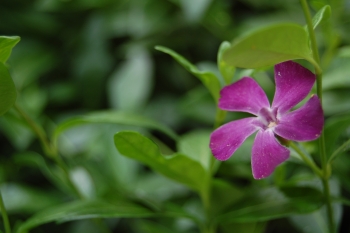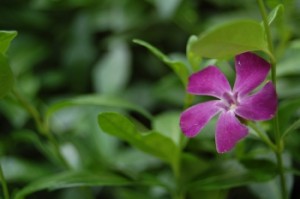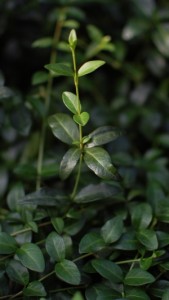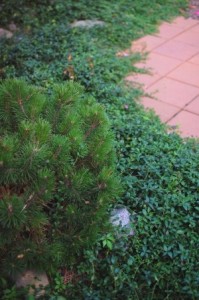Plant Profile: Periwinkle, or Myrtle (Vinca Minor)
There are many lovely plants that make wonderful ground covers – periwinkle is one of my favourites.
Overview
Pros:
- Very low maintenance plant once established – will require some water during dry spells, and occasional weeding.
- Shade tolerant, but enjoys sun as long as it gets enough water (don’t let it fry, though).
- Spreads along the ground quickly – expands about 500% per year.
- Hardy: withstands winters to Canadian Zone 3 (USDA Zone 4).
- Evergreen – it’s the first sign of spring in my garden.
- Plays well with others (at least in my garden) and can be used to cover the earth around taller plants. I’ve done this successfully with peonies, bulbs, and other plants that can be picky about the company they keep. Note: I’ve read some reviews in which gardeners complain that it chokes out other plants.
- Disease resistant, as long as it has good drainage: suitable for pesticide-free gardens.
- Available in a variety of flower colours.
Cons:
- In milder climates can be extremely invasive (in Ottawa it seems to behave). Your local garden center will be able to advise you if it is legal to plant in your area.
- No fragrance.
- Not a North American native; and they don’t seem to appeal to butterflies (I’ve seen bees feeding on their nectar occasionally).
Uses:
- Ground cover, especially in shady areas beneath trees.
- Container plant.
- Erosion control for steep terrain.
Woodland Beauty
My mother introduced me to periwinkle many years ago when she was looking for a ground cover plant that could withstand the deep shade in her heavily-treed yard. Her simple but effective combination of tall trees and large ostrich ferns springing from a deep green bed of periwinkle still inspires me when I visit my parents’ house.
When I was designing my own garden six years ago, I knew I wanted to tear up the flat lawn and create small, gently-sloped hills. There was no question in my mind that these hills would be covered by the luscious, glossy leaves of periwinkle. I purchased six medium-sized pots of Red Wine periwinkle, and within two years had a pretty woodland effect happening in the shady side of my garden. It’s a look I still love many years later.
One of the great benefits of periwinkle is its perpetual greenery, even when all the lawns in the area have burned brown.
Appearance
Periwinkle is a vine that spreads along the ground or can entwine itself on lower objects (but is not usually trained up walls or arbours). The individual tendrils each grow to about 2 feet long, with root nodes developing intermittently along their length, from which new tendrils spread. The plant will generally stand 3 to 6 inches off the ground.
There are several different varieties of periwinkle that show different colours in leaves and flowers. The flowers are five-petaled, and sometimes have a star shape in the centre. Double-flowering cultivars are available. Colours include blue, white, lilac, and mauve. Leaves can be medium to dark green, variegated (green leaves with white or golden areas), or a bright yellow-green. It flowers in the spring, and flowers again through summer on new growth.
Periwinkle is a member of the dogwood family, and is a relative of the larger-leafed and Vinca major.
Conditions
Periwinkle thrives in sandy or clay soils that range from acidic to slightly alkaline (3.7 to 7.8 PH). I add composed manure every year and it seems to do well, however, many sources advise against over fertilizing.
Periwinkle is happy in light levels ranging from deep shade to light sun, but it will need more water the more time it spends in the light.
While very drought tolerant, I find it likes a good drink at least every ten days in order to look its best. Periwinkle can definitely be overwatered, and doesn’t like perpetually wet feet – ensure that the ground is not too swampy – most of the diseases it is subject to are fungal infections brought on by poor drainage.
When Not To Use
A native of central Europe, periwinkle was brought to North America in the 1700s by settlers. In some areas it has become a pest, and is not legal to plant.
On the west coast of Canada and in many areas of the United States, Vinca minor is considered very invasive. Definitely avoid planting this in Pacific rainforest climates. It will not grow well in intensely dry and sunny climates, like those found in the southwestern United States.
A warning: once it is established it is hard to get rid of, even in tougher Canadian climates. In some areas, if you are extremely persistent about pulling it up, you don’t need to dig it out. In others, the soil must be dug up to a depth of about 10 inches and composted for many years.
by Jennifer Priest
Follow me on Google +





Periwinkle sounds perfect for my front lawn under my Schubert cherry tree. Grass always has a hard time there so…